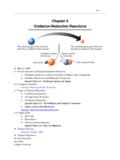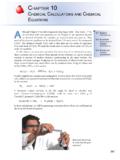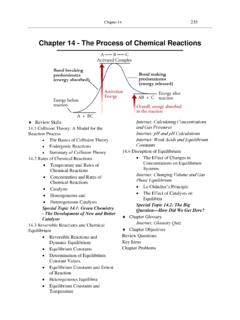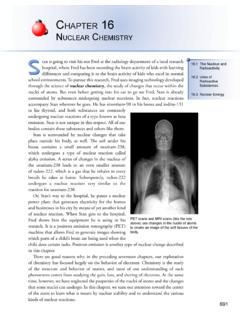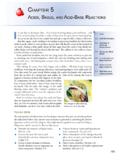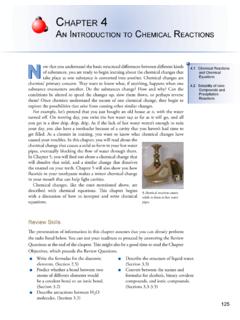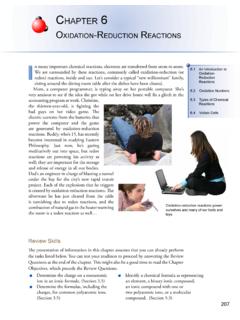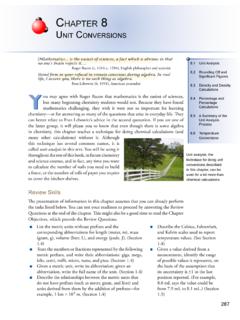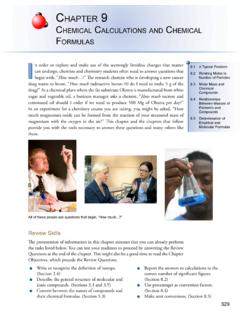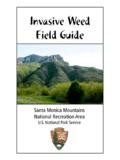Transcription of Chapter 2 t S of M and CheMiCal eleMentS - Mark …
1 Chapter 2the StruCture of Matter and the CheMiCal eleMentS33 One doesn t discover new lands without consenting to lose sight of the shore for a very long Gide French Novelist and Essayistn this Chapter , we begin the journey that will lead you to an understanding of chemistry. Perhaps your ultimate educational goal is to know how the human body functions or to learn how the many parts of a shoreline ecosystem work together. You won t get very far in these studies without a basic knowledge of the CheMiCal principles underlying them. Even before talking about basic CheMiCal principles, though, you must learn some of the language of chemistry and develop an image of the physical world that will help you to think like a important tasks in life require that you learn a new language and new skills.
2 When you are learning to drive a car, for example, your driving instructor might tell you that when two cars reach a four way stop at the same time, the driver on the left must yield the right of way. This statement won t mean anything to you unless you already know what a four way stop is and what is meant by yield and right of way . To drive safely, you need to learn which of the symbols you see on road signs means lane merges ahead or steep grade . You need to learn procedures that will help you make lane changes and parallel park.
3 Chemistry, like driving a car, uses a language and skills of its own. Without a firm foundation in these fundamentals, a true understanding of chemistry is impossible. This Chapter begins to construct that foundation by introducing some key aspects of the chemists view of matter. Review SkillsThe presentation of information in this Chapter assumes that you can already perform the tasks listed below. You can test your readiness to proceed by answering the Review Questions at the end of the Chapter . This might also be a good time to read the Chapter Objectives, which precede the Review Questions.
4 Define matter. ( Chapter 1 Glossary) Write the SI base units for mass and length and their abbreviations. (Section ) Using everyday examples, describe the general size of a meter and a gram. (Section ) Solids, Liquids, and The CheMiCal The Periodic Table of the The Structure of the Common Elements34 Chapter 2 The Structure of Matter and the CheMiCal eleMentS Solids, Liquids, and GasesA chemist s primary interest, as described in Chapter 1, is the behavior of matter, but to understand the behavior of matter, we must first understand its internal structure.
5 What are the internal differences between the granite of Half Dome in Yosemite, the olive oil added to your pasta sauce, and the helium in a child s balloon? A simple model of the structure of matter will help us begin to answer this question. A model is a simplified approximation of reality. For example, architects often build a model of a construction project before actual construction begins. The architect s model is not an exact description of the project, but it is still very useful as a representation of what the structure will be like. Scientific models are like the architects models; they are simplified but useful representations of something real.
6 In science, however, the models are not always physical entities. Sometimes they are sets of ideas the last hundred years, there has been a tremendous increase in our understanding of the physical world, but much of that understanding is based on extremely complicated ideas and mathematics. The application of the most sophisticated forms of these modern ideas is difficult, and not very useful to those of us who are not well trained in modern physics and high level mathematics. Therefore, scientists have developed simplified models for visualizing, explaining, and predicting physical phenomena.
7 For example, we are about to examine a model that will help you visualize the tiny particles of the solid metal in a car s engine block, the liquid gasoline in the car s tank, and the gaseous exhaust fumes that escape from its tail pipe. The model will help you understand why solids have constant shape and volume at a constant temperature, why liquids have a constant volume but can change their shape, and why gases can easily change both their shape and volume. Our model of the structure of solids, liquids, and gases says that All matter is composed of tiny particles.
8 (We will start by picturing these as tiny spheres.) These particles are in constant motion. The amount of motion is related to temperature. Increased temperature reflects increased motion. Solids, gases, and liquids differ in the freedom of motion of their particles and in how strongly the particles attract each other. SolidsWhy does the metal in a car s engine block retain its shape as you drive down the road while the fuel in the car s gas tank conforms to the shape of the tank? What s happening on the submicroscopic level when solid metal is melted to a liquid, and why can molten metal take the shape of a mold used to form an engine block?
9 Our model will help us to answer these questions. According to our model, the particles of a solid can be pictured as spheres held closely together by strong mutual attractions. (Figure ). All the particles are in objeCtive 2objeCtive Solids, Liquids, and Gases 35motion, bumping and tugging one another. Because they re so crowded and exert such strong mutual attractions, however, they only jostle in place. Picture yourself riding on particle 1 in Figure An instant before the time captured in the figure, your particle was bumped by particle 3 and sent toward particle 5.
10 (The curved lines in the figure represent the momentary direction of each particle s motion and its relative velocity.) This motion continues until the combination of a bump from particle 5 and tugging from particles 2, 3, and 4 quickly bring you back toward your original position. Perhaps your particle will now head toward particle 2 at a greater velocity than it had before, but again, a combination of bumps and tugs will send you back into the small space between the same particles. A ride on any of the particles in a solid would be a wild one, with constant changes in direction and velocity, but each particle will occupy the same small space and have the same a solid is heated, the average speed of the moving particles increases.
